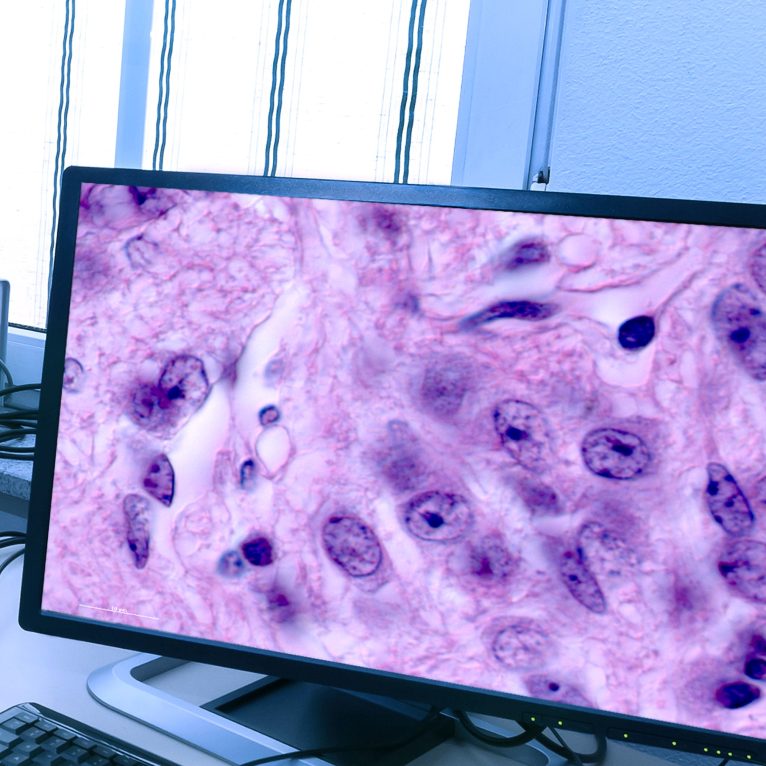
Written by

Cranfield, UK, 6th July 2023
Whilst growth in the overall digital pathology AI market is set to scale quickly, cannibalisation and consolidation are expected to create headwinds for individual AI vendors. How do investors know where their money is safest?
The recent abundance of digital pathology (DP) media coverage can make it hard to remember that not too long ago, this was a market perpetually ‘lagging’ versus other digital healthcare sectors. And whilst growth has now firmly shifted to its ‘log’ phase, there are several facts to bear in mind for investors and stakeholders eyeing this space.
There’s plenty of greenfield opportunity; but not everywhere is primed for harvest.
To utilise DP AI a lab must have access to – and be utilising – a DP scanner. An obvious statement, but one to take careful note of as the number of labs today with access to such scanners is still very low.
Penetration today is also very heterogenous geographically. In North America and particularly the US, vendors have cited digital pathology ‘adoption’ (in terms of scanner placements in labs) for clinical use sits below 10%. Compare this with Western Europe, where some markets like the UK are expected to begin saturating over the next five years, and there is a clear difference between the two. In Asia Pacific, DP has also not taken off as quickly as some expected, with patchy and slow adoption so far in markets like Japan and South Korea, whilst China is again expected to begin saturating over the mid-term.
However, even such country-level generalisations hold distinct nuances. Some Catons in Switzerland for example utilise digital pathology workflows for primary diagnosis in 100% of cases, whereas just next-door, utilisation of the technology is near 0%.
The take-home message is clear: the market is clearly bifurcating between a small number of early-stage adopters scaling their DP usage, and DP newcomers which are growing in number but also are completely new to the practice. As such, whilst the market potential for AI holds great promise AI vendors and investors both should be careful when forecasting potential returns.

Figure 1: Typical process for digital pathology implementations, which can take anywhere from 6 months to two years to fully roll-out.
As Figure 1 shows above, implementation timelines for new adopters can be a lengthy process, with the most capital at the beginning allocated to scanner purchasing at the expense of other products.
Often, the market has seen a prevalence of ‘bundled’ purchasing by new adopters, which elect not to pursue a third-party image management system to keep costs down. After taking a few years to fully evaluate the DP implementation and any associated return on investment, we have seen a significant number of labs seek to replace their scanner-associated software in favour of a more ‘interoperable’ best-of-breed approach.
Because of this, adoption of AI often falls to the back of the line in terms of initial priorities, making the total ‘readily’ addressable market for digital pathology AI still relatively low. Previous years of ‘lag’ growth followed by exponential adoption post COVID-19 and an overall slow implementation process will therefore inevitably create a knock-on ‘lag’ for AI.
A lot of VC funding has been provided, however, return on investment remains comparatively low.
Figure 2 showcases the VC funding landscape for digital pathology from 2014-2022. As is shown, 2021 represented a significant deviation in terms of an abundance of funds poured into the market, a trend quickly reversed the following year.

Figure 2: Public VC Funding for Digital Pathology Vendors 2014-2022 in USDM.
Our most recent digital pathology core update revealed that the worldwide market for image analysis (not just machine learning artificial intelligence) in digital pathology was $104.0MUSD in 2022, with around 50% of that attributed to machine learning and more sophisticated algorithms.
Comparing total market size to such funding levels seem unsustainable. Indeed, as many new and existing entrants begin to scale pressure is being felt universally. The market is already beginning to see consolidation, with Crosscope and KeenEye being acquired quite recently, as our five-year forecast progresses, we expect this trend to continue.
Judging against adjacent markets is also a useful gauge of progress. In medical imaging, a near fully mature digital market that has been leveraging digital technology and image analysis for nearly two decades, spend on AI-based image analysis tools annually is around half a billion dollars, fuelled by over five billion dollars of VC investment across over 200+ start-ups. Here, large-data sets for training exist, regulatory pathways are streamlining and some reimbursement already exists for use of AI tools in clinical practice. Yet even for even for some of the largest and best funded AI vendors (with a handful already with ‘unicorn’ $1B+ valuations, the realities of revenue recognition are much smaller and consolidation is already gathering pace.

Figure 3: Digital Pathology Ecosystem by Vendor Type. Note, this list is not exhaustive, merely intended to showcase examples of digital pathology vendors providing AI software.
Whilst numbers are expected to be thinned in digital pathology also, outlook is not equally bleak for all vendors.
Some companies have sought alternative ways to sure up their financial positions, such as Aiforia’s choice to raise an IPO, or PathAI which acquired a laboratory business; however, a number of vendors have also yet to commercially launch their software and really begin competing in the market.

Table 1: Topmost funded DP vendors 2014-2022.
Table 1 above lists some of the most well-funded vendors, all of which have some sort of AI strategy.
I have my own opinions on which types of vendors are likely to persist/step out soon – if you’re interested subscribe to receive a later insight. For now, I’d also note that with the abundance of vendors competing in this space with similar portfolios, it can be difficult for individual customers to distinguish between different vendors, with some education required on what makes a ‘good’ algorithm and business strategy between these.
Whilst this short piece may seem foreboding, I should again point out that growth in the market is expected to persist. Strong indications in both research and clinical domains have occurred recently, (for clinical think Aiforia’s PD-L1 software being adopted by an NHS trust, Paige’s FDA approval and Ibex Medical’s progress within large labs networks), and with the headwinds expected to be experienced by pathology labs in the short term, digital pathology AI is clearly not just a case of if, but when.
And whilst clinical adoption of DP may be lagging behind, many vendors are choosing to renew focus on research-based applications to sustain themselves. The research segment for DP has long been far more advanced than the clinical, and life sciences, CROs and academics are renewing investment and doubling down on DP workflows. Vendors like PathAI have done very well pursuing such business, and the research market is now slowly beginning to transition from one-off projects to a more platform-based approach to AI. In the short term we expect software and in particular SaaS to start to play a bigger role in new agreements in this space as organisations shift from service-based sales towards products and platforms. In the future therefore, this could be one of the few areas investors will remain willing to dig into their pockets, as timelines to ROI are comparatively shorter.
Related Research
Digital Pathology Market Intelligence Service – World – 2023
Signify Research’s Market Intelligence Service provides a rolling 12-month coverage of the global Digital Pathology market. The service is composed of four deliverables, as shown below.

The service is designed to enable you to:
- Inform product investment and business strategy
- Evaluate the ever-changing competitive landscape to assess the impact of associations and select potential partners
- Acquire a holistic view of the nuances between different pathology research and clinical markets
- Understand adjacent markets such as enterprise imaging, laboratory information systems and the influence these will have on Digital Pathology
For any further questions, or samples of the service contents, please contact the Imogen Fitt, the report author.
About Imogen Fitt
Imogen joined Signify in 2018 as part of the Healthcare IT team. She holds a 1st class Biomedical Sciences degree from the University of Warwick where her studies included molecular biology and pharmacology. Since joining the team Imogen has studied the medical imaging software and hardware markets and is now expanding Signify Research’s Diagnostics and Lifesciences coverage.
About the Diagnostics and Lifesciences Team
The Diagnostics and Lifesciences team provides market intelligence and detailed insights on the multiple healthcare technology markets where the clinical world intersects with the preclinical. Our areas of coverage include digital pathology, laboratory information systems, clinical Real-World Data (cRWD) platforms, oncology information systems, tumour board software, oncology decision support software and radiotherapy IT. Each report provides a data-centric and global outlook of its markets with granular country-level insights. Our research process blends primary data collected from in-depth interviews with healthcare professionals and technology vendors, to provide a balanced and objective view of the market.
About Signify Research
Signify Research provides healthtech market intelligence powered by data that you can trust. We blend insights collected from in-depth interviews with technology vendors and healthcare professionals with sales data reported to us by leading vendors to provide a complete and balanced view of the market trends. Our coverage areas are Medical Imaging, Clinical Care, Digital Health, Diagnostic and Lifesciences and Healthcare IT.
Clients worldwide rely on direct access to our expert Analysts for their opinions on the latest market trends and developments. Our market analysis reports and subscriptions provide data-driven insights which business leaders use to guide strategic decisions. We also offer custom research services for clients who need information that can’t be obtained from our off-the-shelf research products or who require market intelligence tailored to their specific needs.
More Information
To find out more:
E: enquiries@signifyresearch.net
T: +44 (0) 1234 986111
www.signifyresearch.net
